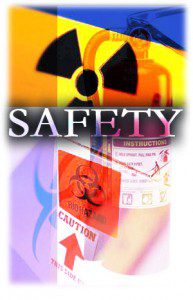 Safety Slogan Myths
Safety Slogan Myths
There are three safety myths that are the cause of 80% of the accidents in the workplace. These myths are
(1) All we need is a program,
(2) Implementation will be easy, and
(3) Inspection is good safety control.
We will dispel each of these myths and show a better alternative.
Myth #1 – All We Need is a Program
Many companies hire a safety consultant so that they can meet the regulatory code. Months later, the company has, one or several, very thick three ring binders full of all kinds of safety jargon. Now, the jargon could actually work if someone deciphered it and transmitted it effectively. In reality, these intelligently written boring books gather dust for years. They are merely an ornament upon which the company safety resides. This is not a safety program. If you believe this is a safety program you are falling for myth #1. A safety program is not a set of binders that gather dust.
Many companies mistakenly think that their end goal is to get a program. In reality, getting a safety program is the beginning goal. Further, a safety program should focus on safety, not jargon and rules. Safety managers need to remember that there is a huge difference between government compliance and real safety.
Myth #2 – Implementation Will be Easy
The best companies have the CECO (chief environmental commitment officer) meet frequently with the board of directors. The reason is that it takes teamwork from everyone to get proper implementation of a safety program. The secret to any safety program is implementation. It is also the hardest task to accomplish. Thinking safety implementation is easy is a myth that has propagated throughout the safety industry and it is false.
There are lots of companies that simply hand out a set of rules and use threats (real or perceived) as motivation. This is a sign that the company doesn’t understand safety or care much about it. These types of companies will tend to lose their best employees as these employees will desire to go to a company that is run more effectively.
Sadly, many industries and small firms simply cannot afford a safety officer of any kind. In these types of industries, you just have to do the best you can. The key point is to have a good communicator with the responsibility of safety dissemination.
Myth #3 – Inspection Brings Control
Safety inspections look at the rules to see how people comply. They look for problems and report them. Typically, after inspection, management tells employees where they failed and reprimand where necessary.
Employees that are reprimanded are often demoralized on some level. And, to make matters worse the person getting blamed is often the wrong candidate. In fact, it is often the person that is least liked by the group.
More importantly, safety inspection looks at what is wrong. This doesn’t bring safety to the company. What makes a company safe is to look at what is being done right and for ways to continue to improve safety. In other words, safety inspections measure non safety and that is what they typically produce.
Finally, safety inspections do not deal with the entire picture. When something goes wrong, it is usually not the fault of one person or one department. Instead, the entire system, as a whole, is the problem and placing individual blame is a way for management to feel like nothing is their fault.
How to Do Safety Right
Companies should get a safety program that is easy to communicate and easy to implement. While this is never the case, it should be the goal of the company. To make the program work, inspections are needed, but the managers should focus on the system as a whole and spend less time assigning blame. Inspiring a good employee to be morally better is much more effective than blaming them.
Finally, make the program fun by using some silly and funny safety slogans.
Safety can be really fun. It is also our mission to make it effective.
Article Source: http://EzineArticles.com/?expert=Kristy_Snow
Discussion
No comments yet.